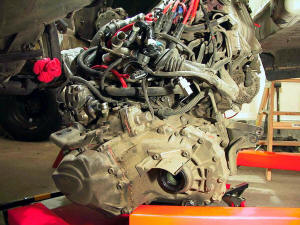08 November, 2004
Rebuilding the 3SGTE (continued)
Transmission and Clutch
First on the agenda was cleaning the case. There were many years worth of baked on dirt and grease:

This seemed like the perfect time to clean it up.
A Dremel grinder is too small to really do the job. It heats up too quickly, and the small wire brushes shed their bristles in no time. I decided to step up to a Makita die grinder, which used larger (1/4" shaft) bits.
While the Makita would handle a larger area, the end brushes I was using would shed their bristles just as fast as the smaller Dremel brushes. And the bristles would stick to everything, especially clothing. Since they were made of stainless steel, trying to remove them with a magnet was useless. And they weren't cheap, either.
I finally found a solution, in a special end brush with a plastic collar around the bristles, called a Vari-Trim brush (McMaster-Carr Part No. 4911-A18). This collar kept the bristles from splaying out and breaking off. Plus, when the bristles were worn down, half of the the collar could be removed to reveal additional bristle length.
While this didn't entirely solve the problem, at least I could work for an hour or so without covering everything in sight (including myself) with tiny stainless steel wire bristles. Although the Vari-Trim brushes were about twice as expensive as the standard type, they lasted long enough to get some serious work done.
In the end, after many hours with the grinder, the results were OK, although the wire brush produced an uneven satin finish, depending on how the light catches the surface. I applied a few coats of clear engine enamel to (hopefully) keep the surface from oxidizing too quickly. Here's a shot of the finished case:
NOTE: This is one of those areas where the published torque specs are questionable. The various M10 mounting bolts used on the transaxle case are threaded into an aluminum casting, yet the torque specs run from 27 ft. lbs. to 57 ft. lbs. I have to say that 57 ft. lbs into an aluminum thread makes me nervous.
McMaster-Carr sells a bushing that is almost a perfect fit. It's their metric flanged bushing Part No. 6659K11. The dimensions are 12mm I.D. and 15mm O.D. It's just a bit too long (12mm), so I ground about 1.5 mm off the length of each one for a perfect fit:
...making certain to smash my thumb with a rubber mallet in the process.
I also applied some Magnalube to the spline.
NOTE: Make sure to check the ball that the release arm pivots on for roughness or other damage. It's a cheap and easy replacement now that will pay off later in smoother clutch action.
Additionally, I need to transfer some components (like motor mounts) from the "old" motor to the "new" motor.